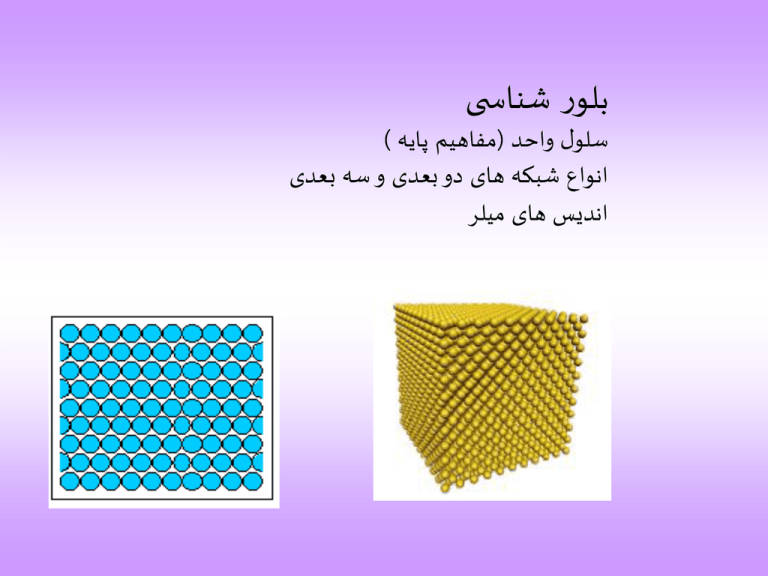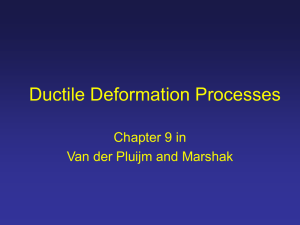Crystal Geometry
advertisement

بلور شناس ی
سلول واحد (مفاهیم پایه )
انواع شبکه های دو بعدی و سه بعدی
اندیس های میلر
تفاوت؟
سلول واحد در شبکه دو بعدی
NaCl سلول واحد در شبکه دو بعدی
Crystal Structure
4
انتخاب دلخواه سلول واحد(حجم یکسان)
5
Crystal Structure
چینش اتمها در سلول واحد مهم نیست
6
Crystal Structure
- or if you don’t start from an atom
Crystal Structure
7
ایا سلول واحد است؟
Crystal Structure
8
ایا سلول مثلثی سلول واحد است؟
9
Crystal Structure
Crystal Lattice
Bravais Lattice (BL)
Non-Bravais Lattice (non-BL)
All atoms are of the same kind
All lattice points are equivalent
Atoms can be of different kind
Some lattice points are not
equivalent
A combination of two or more BL
Crystal Structure
10
پنج شبکه براوه دو بعدی
11
Crystal Structure
یک ملکول هر نوع چرخشی را می تواند داشته باشد
اما شبکه؟
Crystal Structure
13
1-CUBIC
Crystal Structure
14
a- Simple Cubic (SC)
Crystal Structure
15
Face Centered Cubic (FCC)
اتم در سلول واحدش وجود دارد4 •
دارندfcc. (ساختارCu,Ni,Pb..etc) •
Crystal Structure
17
3 - Face Centered
Cubıc
Crystal Structure
18
Atoms are all same.
2 - HEXAGONAL SYSTEM
.سه اتم در سلول واحدش وجود دارد
Crystal Structure
19
2 - HEXAGONAL SYSTEM
Crystal Structure
20
Atoms are all same.
Crystal Structure
21
3 - TRICLINIC
4 - MONOCLINIC CRYSTAL SYSTEM
• تری کلینیک کمترین میزان تقارن را داراست
Triclinic (Simple)
a ß g 90
oa b c
Monoclinic (Simple)
a = g = 90o, ß 90o
a Crystal
b c
Structure
Monoclinic (Base Centered)
a = g = 90o, ß 90o
a b c,
22
5 - ORTHORHOMBIC SYSTEM
Orthorhombic (Simple)
a = ß = g = 90o
abc
Orthorhombic (Basecentred)
a = ß = g = 90o
abc
Orthorhombic (BC)
a = ß = g = 90o
abc
Crystal Structure
Orthorhombic (FC)
a = ß = g = 90o
abc
23
6 – TETRAGONAL SYSTEM
Tetragonal (BC)
a = ß = g = 90o
a=bc
Tetragonal (P)
a = ß = g = 90o
a=bc
Crystal Structure
24
7 - Rhombohedral (R) or Trigonal
Rhombohedral (R) or Trigonal (S)
a = b = c, a = ß = g 90o
Crystal Structure
25
Miller Indices
• اندیس های میلر نمادهایی هستند که جهت صفحات اتمی را در
کریستال مشخص می کنند
• این اندیس ها به گونه ای مشخص می شوند که مجوعه ای بی نهایت
از صفحات بلوری را شامل مشوند
• و نحوه انتخابشان بگونه ای است که هماره صفحه انتخاب شده داخل
سلول واحد قرار می گیرد.
26
Crystal Structure
Example-1
Axis
X
Y
Z
Intercept
points
1
∞
∞
Reciprocals
Smallest
Ratio
1/1 1/ ∞ 1/ ∞
1
Miller İndices
0
0
)100(
(1,0,0)
Crystal Structure
27
Example-2
Axis
X
Y
Z
Intercept
points
1
1
∞
Reciprocals
Smallest
Ratio
(0,1,0)
1/1 1/ 1 1/ ∞
1
Miller İndices
1
0
)110(
(1,0,0)
Crystal Structure
28
Example-3
(0,0,1)
Axis
X
Y
Z
Intercept
points
1
1
1
Reciprocals
(0,1,0)
(1,0,0)
Smallest
Ratio
1/1 1/ 1 1/ 1
1
Miller İndices
Crystal Structure
1
1
)111(
29
Example-4
Axis
X
Y
Z
Intercept
points
1/2
1
∞
Reciprocals
(0,1,0)
(1/2, 0, 0)
Smallest
Ratio
1/(½) 1/ 1 1/ ∞
2
Miller İndices
Crystal Structure
1
0
)210(
30
Example-5
Axis
a
b
c
Intercept
points
1
∞
½
Reciprocals
1/1
1/ ∞
1/(½)
Smallest
Ratio
1
0
2
Miller İndices
Crystal Structure
)102(
31
Example-6
Axis
a
b
c
Intercept
points
-1
∞
½
Reciprocals
1/-1
1/ ∞
1/(½)
Smallest
Ratio
-1
0
2
Miller İndices
Crystal Structure
)102(
32
Miller Indices
[2,3,3]
2
c
Plane intercepts axes at
3a , 2 b , 2 c
Reciprocal numbers are:
1 1 1
, ,
3 2 2
Indices of the plane (Miller): (2,3,3)
b
a
2
Indices of the direction: [2,3,3]
3
(200)
(110)
(100)
Crystal Structure
(111)
(100)
33
اندیس های میلر و جهتهای صفحات اتمی در بلور
اندیس های میلر و جهتهای صفحات اتمی در بلور
جهتهای بلوری و صفحات اتمی عمود بر انها اندیس های میلر یکسانی
دارند.
Crystal Structure
37
Example-7
Crystal Structure
38
Indices of a Family or Form
) {100 } (100 ), ( 010 ), ( 001 ), ( 0 1 0 ), ( 00 1 ), ( 1 00
) {111 } (111 ), (11 1 ), (1 1 1), ( 1 11 ), ( 1 1 1 ), ( 1 1 1), ( 1 1 1 ), (1 1 1
این } {hklنماد کلیه اندیس های میلر مربوط به صفحات ) (hklرا شامل می شود
که بوسیله چرخش به همدیگر مر بوط می شوند
39
Crystal Structure
3D – 14 BRAVAIS LATTICES AND THE SEVEN CRYSTAL SYSTEM
. شبکه براوه وجود دارد که فضای سه بعدی را می پوشاند14 تنها
. شبکه نیز در هفت سیستم بلوری معرفی شده گنجانده می شوند14 این
•
•
•
•
•
•
•
•
•
Cubic Crystal System (SC, BCC,FCC)
Hexagonal Crystal System (S)
Triclinic Crystal System (S)
Monoclinic Crystal System (S, Base-C)
Orthorhombic Crystal System (S, Base-C, BC, FC)
Tetragonal Crystal System (S, BC)
Trigonal (Rhombohedral) Crystal System (S)
Crystal Structure
40
3–Hexagonal Close-Packed Str.
Crystal Structure
41
Hexagonal Close-packed Structure
a=b a=120, c=1.633a,
basis : (0,0,0) (2/3a ,1/3a,1/2c)
Crystal Structure
42
Packing
Close pack
A
A
B
AC
AC
B
B
AC
A
A
B
AC
AC
B
B
AC
B
A
AC
B
AC
AC
B
A
B
B
AC A
B
A
A
A
B
A
B
A
A
A
B
A
A
A
Sequence ABABAB..
-hexagonal close pack
Sequence ABCABCAB..
??
Crystal Structure
Sequence AAAA…
- simple cubic
Sequence ABAB…
- body centered cubic
43
First Brillouin Zone: Two
Dimensional Oblique Lattice
First Four Brillouin Zones: Square
Lattice
All Brillouin Zones: Square Lattice
Primitive Lattice Vectors: BCC
Lattice
First Brillouin Zone: BCC
Primitive Lattice Vectors: FCC
Brillouin Zones: FCC
First Brillouin Zone BCC
First Brillouin Zone FCC
X-ray Diffraction
E hc /
Typical interatomic distances in solid are of the order of an angstrom
Thus the typical wavelength of an electromagnetic probe of such dis
Must be of the order of an angstrom.
Upon substituting this value for the wavelength into the
energy equation,
We find that E is of the order of 12 thousand eV, which is a
typical X-ray
Energy. Thus X-ray diffraction of crystals is a standard
Wavelength vs particle energy
Bragg Diffraction: Bragg’s Law
Bragg’s Law
The integer n is known as the order of the corresponding
Reflection. The composition of the basis determines the
relative
Intensity of the various orders of diffraction.
Many sets of lattice planes produce
Bragg diffraction
BRAGG’s EQUATION
Deviation =
2
Ray 1
Ray 2
The path difference between ray 1 and ray 2 = 2d Sin
For constructive interference: n = 2d Sin
d
Bragg Spectrometer
Bragg Peaks
A beam of X-rays directed at a crystal interacts with the
electrons of the atoms in the crystal
The electrons oscillate under the influence of the incoming
X-Rays and become secondary sources of EM radiation
The secondary radiation is in all directions
The waves emitted by the electrons have the same frequency
as the incoming X-rays coherent
The emission will undergo constructive or destructive
interference with waves scattered from other atoms
Incoming X-rays
Secondary
emission
Sets Electron cloud into oscillation
Sets nucleus (with protons) into oscillation
Small effect neglected
Oscillating charge re-radiates In phase with the incoming x-rays
von Laue Formulation of X-Ray
Diffraction
Condition for Constructive
Interference
Bragg Scattering
=K
The Laue Condition
Ewald Construction
Crystal structure determination
Many s (orientations) POWDER
Monochromatic X-rays Powder specimen
METHOD
Panchromatic X-rays
Single
Monochromatic X-rays Varied by rotation
LAUE
TECHNIQUE
ROTATING
CRYSTAL
METHOD
THE POWDER METHOD
Cone of diffracted rays
POWDER METHOD
Diffraction cones and the Debye-Scherrer geometry
Different cones for different re
Film may be replaced with detector
http://www.matter.org.uk/diffraction/x-ray/powder_method.htm
Schematic X-Ray Diffractometer
Detecto
r
XRay
Sourc
e
Powdered
sample
Sample XRD Pattern
strong intensity = prominent crystal
plane
weak intensity = subordinate crystal
plane
background
radiation
Determine D-Spacing from XRD patterns
Bragg’s Law
nλ = 2dsinθ
• n = reflection order (1,2,3,4,etc…)
• λ = radiation wavelength (1.54 angstroms)
• d = spacing between planes of atoms
(angstroms)
• θ = angle of incidence (degrees)
strong intensity = prominent crystal
plane
nλ = 2dsinθ
(1)(1.54) = 2dsin(15.5
degrees)
1.54 = 2d(0.267)
d = 2.88 angstroms
background
radiation
d-spacing
2.88
2.18
1.81
1.94
2.10
1.75
2.33
2.01
1.66
1.71
Intensity
100
46
31
25
20
15
10
10
5
5
The Bragg equation may be rearranged (if n=1)
from n 2 d sin
to
2
4d
sin
2
2
If the value of 1/(dh,k,l)2 in the cubic system equation above is inser
this form of the Bragg equation you have
sin
2
2
4a
2
2
(h k
2
2
l )
Since in any specific case a and are constant and if 2/4a2 = A
sin A ( h k
2
2
pma 2010
2
2
l )
Insert the values into a table and compute sin and sin2.
Since the lowest value of sin2 is 3A and the next is 4A the first
Entry in the Calc. sin2 column is (0.10854/3)*4 etc.
d/Å
Sin
Sin2
Calc. Sin2
2.338
0.32945
0.10854
2.024
0.38056
0.14482
0.14472
(2,0,0)
1.431
0.53826
0.28972
0.28944
(2,2,0)
1.221
0.63084
0.39795
0.39798
(3,1,1)
1.169
0.65890
0.43414
0.43416
(2,2,2)
1.0124
0.76082
0.57884
0.57888
(4,0,0)
0.9289
0.82921
0.68758
0.68742
(3,3,1)
0.9055
0.85063
0.72358
0.72360
(4,2,0)
(1,1,1)
The reflections have now been indexed.
pma 2010
(h, k, I)







